with Geo Dunn and Dave Hahn of International Mountain Guides
with Geo Dunn and Dave Hahn of International Mountain Guides |
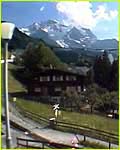 Jungfrau from train [click to zoom] |
Up early (1am) for our first climb. Everyone else is up too, most have slept pretty lightly anyway. The high altitude (11,000') means that brains have been getting by with less oxygen than usual and brains don't like that. The anxiety of an upcoming climb usually keeps a few awake; it is part of the game to sit up worrying from time to time. Then there is the fact that most of us aren't really used to sleeping with so many strangers (even if they are climbers) at once. That tends to keep people sleeping lightly if at all. So there was a sense of relief when the time actually came to fold our two blankets each and arrange them neatly again under our hut-issued pillows.
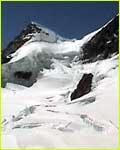 Jungfrau [click to zoom] |
On with the boots, and then I just drag my whole gig outside into the cool night to finish gearing up. Gaiters on, harness on and doubled back, crampons on, pack squared away. Making sure that all are close to being set, we grab ice axes and move 100 feet down and onto the glacier. We trudge as a group of seven, by headlight and without a word, along the CAT-groomed track across the head of the Aletsch Glacier, one of the biggest in the Alps.
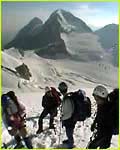 The Eiger and Monch viewed from Jungfrau [click to zoom] |
A slight climb brings us near to the rock ridge. I'm trying hard to suss out the situation up ahead while keeping moving. It looks to be a few exposed moves getting from the glacier to the rock. How exposed though? Will I need to short-rope or place pro? Or can I just keep it moving, which would probably be a good thing with the growing string of headlights behind me? Turns out to be a well trod set of problems. There are good steps hacked in the hard water ice of the transition to rock and the rock is then very straightforward. I can keep it stretched and get well onto the rock before establishing a quick belay to bring Mike and Marilyn up. Now, with the rope shortened, we begin weaving up a set of crampon scratches along the spine of the ridge. We don't need hands for this first part, just well placed feet.
It is important as hell that we don't knock loose rock onto the slope below us. George is below us — never kick rock on the boss. He isn't below us for long. I slow to a stop at a wall of lower 5th class rock and Geo catches up. It is worth taking off the crampons. I run out a bit of rope for this short wall and clamber up to an obvious belay ledge. Marilyn and Mike dance on up as I bring in rope. We shorten up again and head out on ledges and scratches to the left. Rounding a corner, the route now goes up on solid, pleasant, relatively low angled rock. We only occasionally use hands on it, and less so as we move upward. Time for a rest and time to pull cameras out for a pretty sunrise in clear skies.
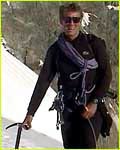 Geo Dunn [click to zoom] |
First there is a steep, firm snow slope that needs traversing for 120 feet on a narrow track. This is a bottleneck since each guide, upon crossing the slope, then must set up a formal belay to get his folks safely onto the steep rock. I get myself part way out and observe that the team of Belgians behind us is not good at waiting. They've started directly up the 50° slope. The guide is twisting in ice screws when there is an odd commotion. We all look up and at first see nothing but a curious spray of snow crystals coming down the slope. Then, in an instant, the world is full of action and yelling as a rock the size of a sofa cushion comes leaping, bounding and skipping into view, just above and as it turns out, to one side of the Belgian team lined up vertically on the hill. It hurtles between them and us, crosses the track and keeps right on flying down the back of the Jungfrau. A good reason not to linger.
The Belgians decide to get back in line. I decide to get after George. It is slower going on this rock though. There are fine metal stanchions just where it makes sense to belay one's team up, but then there are many more stanchions. Lots of rock scrambling to be done, none of it impossible, but all of it exposed. All of it requiring concentration, which becomes a little difficult to maintain with about four teams now in essentially the same bit of mountain and in various stages of passing one another.
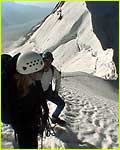 Upper Jungfrau [click to zoom] |
Even the Monch and the Eiger across the way are lower, we rule the heights. So it must be time to get working downward. We reverse the process on the rocky ridge. It is a somewhat tedious process as the day heats up and the rope teams jam up from time to time. We pick our way down for hours. It is a relief to hit the snow and a relief to get the final loose rock ridge safely behind us. But the relief is short-lived. The sun is mercilessly frying us as we come to the downside of beginning a climb by descending. It then means finishing a climb by ascending. We drag on up. A trudge now in the sloppy mid-afternoon snow, mitigated only by the thought of an icy cold beverage to be had inside the Jungfraujoche station when we top out at the CAT track once more.
Geo and I are last up, having coiled our ropes and watched as half our crew chose to return directly to the hut while we and a couple more pursue the cokes inside. For some reason, we linger in the station and find ourselves walking alone back the 45 minutes to the hut. At 15 minutes, all hell broke loose and the hail started pummeling us and the lightning started, the kind of strikes where you see them somewhere back behind your eyeballs and hear the thunder in about that same little cranial space at roughly the same time. Still, you don't run so well in mushy snow with a pack on your back after 12 hours of hellaciously good climbing. Besides, I didn't want George to think I was scared. We lived. And when we hauled ourselves in the door of the Monchjoch Hutte, it seemed like we lived the good life. Beer and a four course meal heals a lot of hail and lightning wounds.
Not Climbing The Monch
The Monch day dawned ugly. Just at the point of booting up to exit the hut, George made the good call to put things on hold. As we began our wait and sampled the coffee, the view was limited to a few hundred yards of early morning murk. The local guides sat together at a table across the room. I found myself relieved to see them laughing and chatting together. I suspect they are taught to be quiet, reserved, strong and competent, which is great but somewhat intimidating for us foreigners.
Switching gears from the methodical scurrying of an Alpine start to killing time, watching the weather, waiting to see that we found ourselves in didn't bother me in the least. In part because George had the big responsibility to make the right call and I didn't. I knew he'd get it right, as he's often done the right thing 23 years into his career as a professional climbing guide. The right thing on that day turned out to be riding the train back down to Wengen. That happens. It wasn't the "storm of the century" and the route on the Monch is not the "overhanging death route" or anything, but climbing exposed wet rock and tight snow aretes while being harassed by wind and snow was not in our best interest. We went down and showered, read the paper and ate good food in Wengen.
— Dave Hahn, International Mountain Guides
| PAGE 2 of 5 | |
|
|